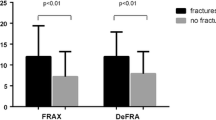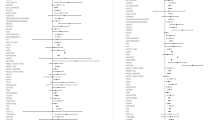Abstract
Both retrospectively and prospectively designed studies consistently show low bone mass and/or bone mineral content (BMC) to be risk factor for low-trauma fractures in postmenopausal women. Along with the reports of such studies there has been concern expressed that BMC measurements overlap between fracture groups, i.e., some women with high BMC develop fractures and some women with low BMC do not. In these commonly used epidemiologic study designs, BMC does not discriminate between those who have and have not experienced the untoward event at some level of the exposure factor. The ability to discriminate is more properly determined by the sensitivity and specificity of the measured value. To contrast the concepts of risk and sensitivity, a nested case-control study was conducted within a 24-year cohort study of women at risk for osteoporosis. We found that for each 1.0 decrement of BMCz-scores, the adjusted relative risk for the prospective study design was 1.67, while the odds ratio obtained from the most recent BMCz-score measurements was 1.87. A receiver operating characteristic (ROC) curve, calculated from the nested case-control study data, showed that BMCz-scores, measured after low-trauma fracture, have both low sensitivity and low specificity to detect existing fracture status.
Similar content being viewed by others
References
Hall FM, Baran CT. Bone mineral screening for osteoporosis. N Engl J Med 1987;316:212–14.
Bohr H, Schaadt O. Bone mineral content of femoral bone and lumbar spine measured in women with fracture of the femoral neck by dual photon absorptiometry. Clin Orthop 1983;179:240–5.
Riggs BL, Wahner HW, Seeman E, et al. Changes in bone mineral density of the proximal femur and spine with aging. J Clin Invest 1982;70:716–23.
Horsman A, Nordin BEC, Simpson M, et al. Cortical and trabecular bone status in elderly women with femoral neck fracture. Clin Orthop 1982;166:143–51.
Firooznia H, Rafi M, Golimbu C, et al. Trabecular mineral content of the spine in women with hip fracture: CT measurement. Radiology 1986;159:737–40.
Heaney RP. Bone mass and osteoporotic fractures. Calcif Tissue Int 1990;47:63–5.
Hui SL, Slemenda CW, Johnston CC. Baseline measurement of bone mass predicts fracture in white women. Ann Intern Med 1989;111:355–61.
Ross PD, Wasnich RD, Vogel JM. Detection of prefracture spinal osteoporosis using bone mineral absorptiometry. J Bone Miner Res 1988;3:1–11.
Ross PD, Wasnich RD, Heilbrun LK, et al. Definition of a spine fracture threshold based upon prospective fracture risk. Bone 1987;8:271–278.
Wasnich RD, Ross PD, MacLean CJ, et al. A prospective study of bone mass measurements and spine fracture incidence. In: Christiansen C, S. JJ. Riis BJ, editors. Osteoporosis 1987. Copenhagen: Osteopress, 1987: 377–8.
Cummings SR, Nevitt MC, Black DM, et al. The study of osteoporotic fractures: A multicenter prospective study of predictors of hip and wrist fractures. In: Christiansen C, Johansen JS, Riis BJ, editors. Osteoporosis 1987. Copenhagen: Osteopress, 1987:58–9.
Wasnich RD, Ross PD, MacLean CJ, et al. The relative strengths of osteoporotic risk factors in a prospective study of postmenopausal osteoporosis. In: Christiansen C, Johansen JS, Riis RJ, editors. Osteoporosis 1987. Copenhagen: Osteopress, 1987:394–5.
Smith DM, Khairi MRA, Johnston CC. The loss of bone mineral with aging and its relationship to risk of fracture. J Clin invest 1975;56:311–18.
Gardsell P, Johnell O, Nilsson BE. Predicting fractures in women by using forearm bone densitometry. Calcif Tissue Int 1989;44:235–42.
Wasnich RD, Ross PD, Heilbrun LK, et al. Prediction of postmenopausal fracture risk with use of bone mineral measurements. Am J Obstet Gynecol 1985;153:745–51.
Khairi RA, Cronin JH, Robb JA, et al. Femoral trabecular-pattern index and bone mineral content measurement by photon absorption in senile osteoporosis. J Bone Joint Surg 1976;58-A:221–6.
Gardsell P, Johnell O, Nilsson BE, et al. The predictive value of fracture, disease, and falling tendency for fragility fractures in women. Calcif Tissue Int 1989;45:327–33.
Melton LJ, Chao EYS, Lane J. Biochemical aspects of fractures. In: Riggs BL, Melton LJ, editors. Osteoporosis: etiology, diagnosis and management. New York: Raven Press, 1988:111–31.
Melton LJ, Wahner HW, Richelson LS, et al. Osteoporosis and the risk of hip fracture. Am J Epidemiol 1986;124:254–61.
Cummings SR. Are patients with hip fractures more osteoporotic? Am J Med 1985;78:487–94.
Krolner B, Nielsen SP. Bone mineral content of the lumbar spine in normal and osteoporotic women: cross-sectional and longitudinal studies. Clin Sci 1982;62:329–36.
Cann CE, Genant HK, Kolb FO, et al. Quantitative computed tomography for prediction of vertebral fracture risk. Bone 1985;6:1–7.
Bohr H, Schadt O. Bone mineral content of femoral bone and the lumbar spine measured in women with fracture of the femoral neck by dual photon absorptiometry. Clin Orthop Rel Res 1983;179:240–5.
Ott SM, Kilcoyne RF, Chesnut CH. Ability of four different techniques of measuring bone mass to diagnose vertebral fractures in postmenopausal women. J Bone Miner Res 1987;2:201–10.
Genant HK, Steiger P, Block JE, et al. Quantitative computed tomography: update 1987. Calcif Tissue Int 1987;41:179–86.
Cummings SR, Kelsey JL, Nevitt MC, et al. Epidemiology of osteoporosis and osteoporotic fractures. Epidemiol Rev 1985;7:178–208.
Cummings SR, Black D. Should perimenopausal women be screened for osteoporosis? Ann Intern Med 1986;104:817–23.
Heaney RP. Osteoporotic fracture space: an hypothesis. Bone Miner 1989;6:1–13.
Pacifici R, Susman N, Carr PL, et al. Single and dual energy tomographic analysis of spinal trabecular bone: A comparative study in normal and osteoporotic women. J Clin Endocrinol Metab 1987;64:209–14.
Reinbold WD, Genant HK, Reiser, UJ, et al. Bone mineral content in early-postmenopausal and postmenopausal osteoporotic women: comparison of measurement methods. Radiology 1986;160:469–78.
Riggs BL, Wahner HW, Dunn WL, et al. Differential changes in bone mineral density of the appendicular and axial skeleton with aging. Relationship to spinal osteoporosis. J Clin Invest 1981;67:328–35.
Heaney RP, Recker RR, Saville PD. Calcium balance and calcium requirements in middle-aged women. Am J Clin Nutr 1977;30:1603–11.
Cameron JR, Sorenson J. Measurement of bone mineral in vivo: an improved method. Science 1963;142:230–2.
Hui SL, Slemenda CW, Johnston CC. Age and bone mass as predictors of fracture in a prospective study. J Clin Invest 1988;81:1804–9.
Ettinger B, Genant HK, Cann CE. Long-term estrogen replacement therapy prevents bone loss and fractures. Ann Intern Med 1985;102:319–24.
Seeley DG, Browner WS, Nevitt MC, et al. Which fractures are associated with low appendicular bone mass in elderly women? Ann Intern Med 1991;115:837–42.
Gallagher JC, Melton LJ, Riggs BL, et al. Epidemiology of fractures of the proximal femur in Rochester, Minnesota. Clin Orthop Rel Res 1980;150:163–71.
Davies KM, Recker RR, Heaney RP. Normal vertebral dimensions and normal variation in serial measurements of vertebrae. J Bone Miner Res 1989;4:341–9.
Davies KM, Recker RR, Heaney RP. Revised criteria for vertebral deformity. J Bone Miner Res 1990;5:S117.
Fletcher RH, Fletcher SW, Wagner EH. Clinical epidemiology. Baltimore: Williams & Wilkins, 1982.
Cox DR. Regression models and life tables. J R Stat Soc 1972;34:187–220.
Kahn HA, Sempos CT. Statistical methods in epidemiology. New York: Oxford University Press, 1989.
Selvin S. Statistical analysis of epidemiologic data. New York: Oxford University Press, 1991.
Colditz GA, Martin P, Stampfer MJ, et al. Validation of questionnaire information on risk factors and disease outcomes in a prospective cohort study of women. Am J Epidermiol 1986;123:894–900.
Schlesselman JJ. Case-control studies. New York: Oxford University Press, 1982.
Kleinbaum DG, Kupper LL, Morgenstern H. Epidemiologic research. Belmont (CA): Lifetime Learning Publications, 1982.
Melton LJ. Epidemiology of fractures. In: Riggs BL, Melton LJ, editors. Osteoporosis: etiology, diagnosis, and management. New York: Raven Press, 1988:133–54.
Riggs BL, Melton LJ. Evidence for two distinct syndromes of involutional osteoporosis. Am J Med 1983;75:899–901.
Cummings SR, Nevitt MC. A hypothesis: The cause of hip fractures. J Gerontol 1989;44:m107-m111.
Ross PD, Davis JW, Vogel JM, et al. A critical review of bone mass and the risk of fractures in osteoporosis. Calcif Tissue Int 1990;46:149–61.
Kreiger N, Kelsey JL, Holford TR, et al. An epidemiologic study of hip fracture in postmenopausal women. Am J Epidemiol 1982;116:141–8.
Naessen R, Ingeman P, Hans-Olov A, et al. Hormone replacement therapy and the risk for first hip fracture. Ann Intern Med 1990;113:95–103.
Paganini-Hill A, Ross Rk, Gerkins VR, et al. Menopausal etrogen therapy and hip fractures. Ann Int Med 1981;95:28–31.
Johnson RE, Specht EE. The risk of hip fracture in postmenopausal females with and without estrogen drug exposure. Am J Public Health 1981;71:138–44.
Weiss NS, Ure CL, Ballard JH, et al. Decreased risk of fractures of the hip and lower forearm with postmenopausal use of estrogen. New Engl J Med 1980;303:1195–8.
Author information
Authors and Affiliations
Rights and permissions
About this article
Cite this article
Stegman, M.R., Recker, R.R., Davies, K.M. et al. Fracture risk as determined by prospective and retrospective study designs. Osteoporosis Int 2, 290–297 (1992). https://doi.org/10.1007/BF01623185
Received:
Accepted:
Issue Date:
DOI: https://doi.org/10.1007/BF01623185




